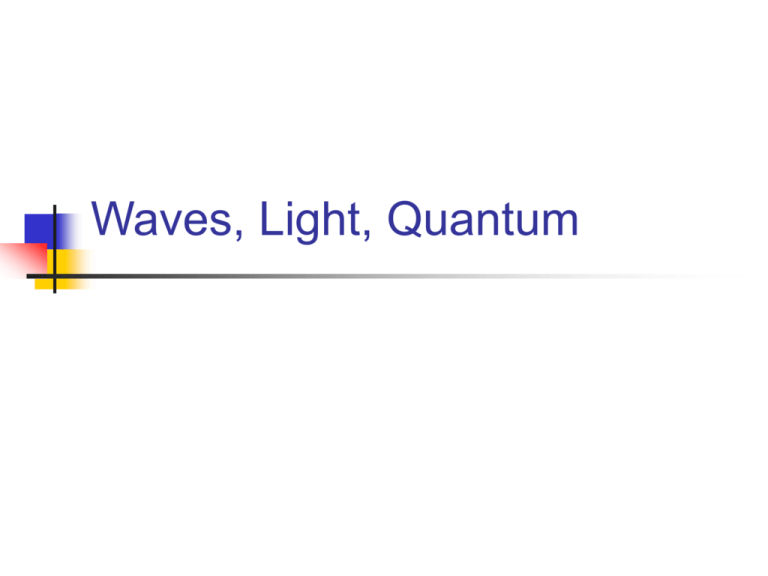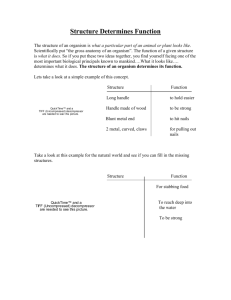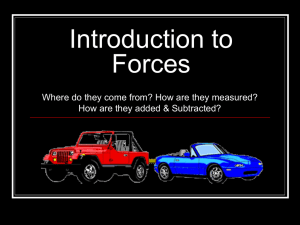PowerPoint Presentation - What Is Light?
advertisement

Waves, Light, Quantum Figure 4.1: Molar Volume (elements known in 1869) (a few more recently discovered elements added) Other Periodic Trends QuickTime™ and a TIFF (LZW) decompressor are needed to see this picture. View of White Light Through Spectroscope (Investigate This 4.5) white light viewed through slit QuickTime™ and a TIFF (LZW) decompressor are needed to see this picture. light separated into different wavelengths by diffraction grating View of White Light Source Through KMnO4 Solution (Investigate This 4.5) white light source QuickTime™ and a TIFF (LZW) decompressor are needed to see this picture. white light source covered with permanganate solution KMnO4 Color of Wavelengths Absorbed is Complementary To Color Observed QuickTime™ and a TIFF (LZW) decompressor are needed to see this picture. QuickTime™ and aQuickTime™ and a QuickTime™ and a TIFF (LZW) decompress or GIF decompressor TIFF (LZW) decompress or are needed to s ee this pic ture. are needed to s ee this pic ture. are needed to see this picture. Purple Appearing Light Emission vs. Absorption (Consider This 4.7) prism (wavelength separator) light source QuickTime™ and a TIFF (LZW) decompressor are needed to see this picture. some matter (light absorber) white light source Light = Electromagnetic Waves Electromagnetic radiation the emission and transmission of energy in the form of electromagnetic waves Properties of Waves one cycle wavelength amplitude = wavelength = length of one cycle n = frequency = number of cycles/time Properties of Waves xn=c c = velocity of light wave in vacuum = 3.00 x 108 m/s Problem 4: A laser used to weld detached retinas produces light with frequency of 4.69 x 1014 Hz. What is this wavelength in nm? To what part of the electromagnetic spectrum does this light belong? (1Hertz = 1 s-1.) = c/n = (3.00 x 108 m/s) / 4.69 x 1014 Hz = 6.40 x 10-7 m = 640 nm (red region of visible spectrum) Waves In a Ripple Tank (Investigate This 4.12, 4.16) Click on ripple tank wave simulation For 4.12 Set to Setup: Single Source; 1 Src, 1 Freq; Color Scheme 3 For 4.16 Change Setup to Double Slit (source automatically switches to 1 Plane Src, 1 Freq) Planck’s Quantum Theory Planck’s Basic Ideas E states of a system (e.g., atom) are quantized, not continuous state 3 state 2 E state 1 Classical Physics View continuous E states Planck’s Quantum View quantized E states Planck’s Basic Ideas Only certain E increments may be absorbed or emitted by system state 3 state 2 E emissions state 1 Classical Physics View continuous E states infinite #of DE possible Planck’s Quantum View only transitions allowed are between quantized E states Planck’s Basic Ideas Energy is emitted or absorbed in discrete units (quanta) state 3 DE = hn (Planck’s Law) h = 6.63 x 10-34 J•s state 2 E state 1 DE31 = hn The Photoelectric Effect Light strikes metal surface and ejects an electron hn e- Classical physics predicts light intensity determines if e- is ejected. But e- is ejected only if light of minimum n (no) is used; intensity does not matter. The Photoelectric Effect Einstein: Quantum Theory Explains the PE Effect Light is a stream of photons Ephoton = hn e- oo e-removed oo oo 1 1 1 Eee- in metal Ephoton = DEee- ejected Ephoton > DEe- Ephoton < DEe- e- ejected with kinetic energy e- not ejected What is no? (What is n needed to eject e-?) How much E must the e- absorb if it moves from n=1 to n= ? oo oo DEe- = Ee-,n=oo - Ee-,n=1 Ee- This increase in Ee- is supplied by the photon DEe- = Ephoton = hno or no = DEe- /h 1 DE1oo = hno


